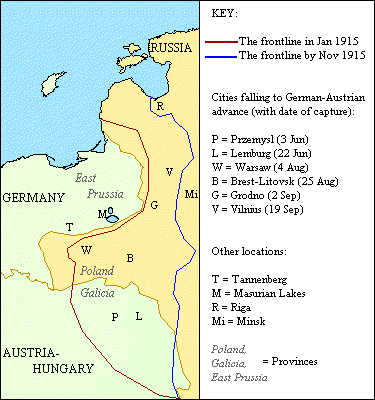 |  |  |  |  |  |  |  |  |  |  |  |  |  |  |  |  |  |  |  |
 |
|
1915 |
|
|
|
That flesh we had nursed from the first in all cleanness was given...
To be blanched or gay-painted by fumes - to be
cindered by fires -
To be senselessly tossed and retossed in stale mutilation
From crater to crater. For this we shall take expiation.
But who shall return to us our children?
|
|
|
|
|
|
-- Rudyard Kipling, "The Children" |
|
|
 |
|
|
By the beginning of 1915, Germany has not achieved the decisive victory over France that she had hoped for, but she does occupy
almost all of Belgium and the industrial heartland of northern France, which together give a valuable boost in coal, iron ore and industrial production to the German economy. As a result, German policy on the Western front during 1915 is - apart from
one determined effort to finally eliminate the Ypres salient at the Second Battle of Ypres (April-May 1915) - strictly defensive, designed to hold on to her gains. The German Army is content to entrench ever more deeply in the
positions it held at the end of 1914, leaving the Allies to take the offensive against the static, fortified German line. In the meantime, the Germans transfer all resources that can be spared from the Western Front to the east, where greater distances
and wide open expanses make trench warfare impractical, and promise a continuing war of movement and the possibility of decisive victories. German Chief of Staff Erich von Falkenhayn sums up Germany's strategy for 1915: |
|
|
|
"Hold the solid wall in the west and let the British and French dash themselves against it;
strike down Russia in the
east".
|
|
|
|
 |
|
|
|
Map: The Eastern Front in 1915 |
|
|
|
|
|
On the Eastern Front, the year begins with Russia on the offensive against both Germany and Austria-Hungary. Russia enjoys
considerable success against the latter, capturing the mighty Carpathian fortress-city of Przemsyl, but her invasion of East Prussia is brought to an end by the overwhelming German victory at the Battle of the Masurian Lakes (February 1915). After this
defeat, the Russian Army will not set foot on German territory again for the rest of the war. To end the drain on German resources caused by the need to prop up the Austrian Front against the Russians, Germany takes the offensive in the east during the
summer of 1915, with the goal of finally forcing Russia out of the war. German breakthroughs in Galicia (in May 1915) and Poland (in June) push the entire Russian line back in disarray for as much as 300 miles, with massive losses to the Russian Army of
both men (2,000,000 casualties for the year as a whole) and equipment. |
|
|
|
|
|
On the Western Front, with French and Belgian territory under German occupation, the Allies can not be content as Germany is
with maintaining the status quo. In 1915, a German peace proposal makes clear that Germany intends to permanently retain her gains of 1914, and the Allies are faced with the reality that they will have to take the offensive if occupied Belgium and
France are to be liberated. The difficulty facing the Anglo-French armies throughout 1915 is how to break through a fortified German defence from a static front line. Numerous attempts to break through result in hundreds of thousands of casualties for
minimal gain. In a series of costly failures, in the French Army's Artois and Champagne campaigns, and the BEF's offensives at Neuve Chapelle, Festubert, Aubers Ridge and Loos, the Allies learn that it is impossible to push infantry through a
heavily-fortified defensive line more quickly than the enemy can bring up reserves to plug the gap. |
|
|
|
Allied Offensives on the Western Front during 1915 |
|
|
|
 |
|
|
|
Faced with continuing stalemate on the Western Front, the Allies adopt a new strategy of attacking German through her
apparently weaker Turkish ally, rather than head-to-head in the west. In April and August 1915, British forces (with Australians and New Zealanders playing a prominent role) launch an amphibious assault on the Gallipoli Peninsula, with the goal of
opening the Dardanelles to the Royal Navy and advancing on the Turkish capital, Constantinople. But the Allied landings are disorganised and confused and, in the face of tenacious Turkish resistance, the Gallipoli campaign is
reduced to a costly stalemate. In December 1915 and January 1916, the Allies evacuate their precarious toehold on Turkish soil, having suffered over 50,000 troops killed on the peninsula, for no gain.
Apart from Gallipoli, other new war fronts
emerge during 1915. On 23 May, Italy joins the Allies, but her alpine war against Austria-Hungary quickly falls into the same static warfare as the Western Front. In the Middle East, British forces in Egypt successfully repel an attack on the Suez
Canal from the Turkish province of Palestine, but an ambitious British offensive in Mesopotamia is halted at Ctesiphon in November 1915 (and will conclude five months later with the humiliating surrender at Kut-al-Amarah of the surviving remnants of the
British expedition). The disastrous progress of the 1915 Mesopotamian campaign is symptomatic of a year of Allied disappointment on all fronts: with failed French and British breakthroughs in the west and at Gallipoli; decisive defeat for Russia on the
Eastern Front and, in the Balkans, the final defeat of Serbia, which falls to a German-Austrian-Bulgarian invasion force in December 1915.
|
|
|
 |
|
|
 |
|
 |
|
 |
|
|
|
or return to the Great War Home page |
|

